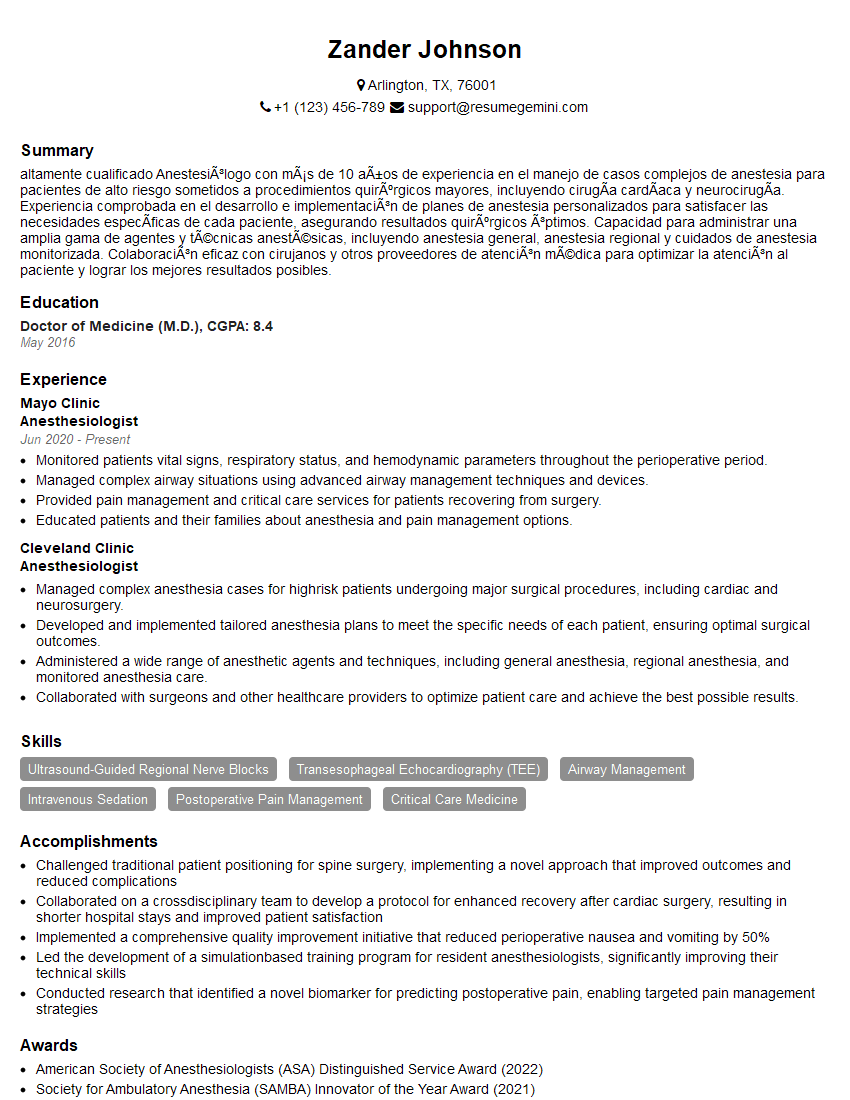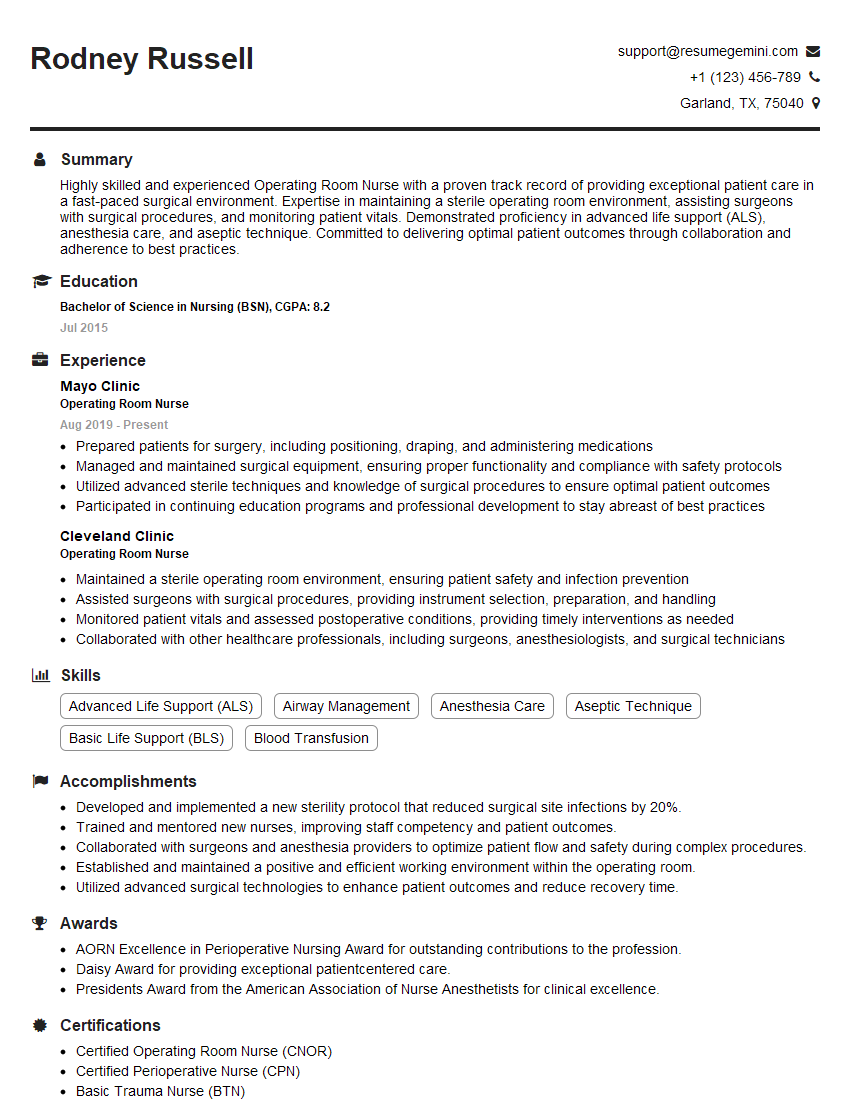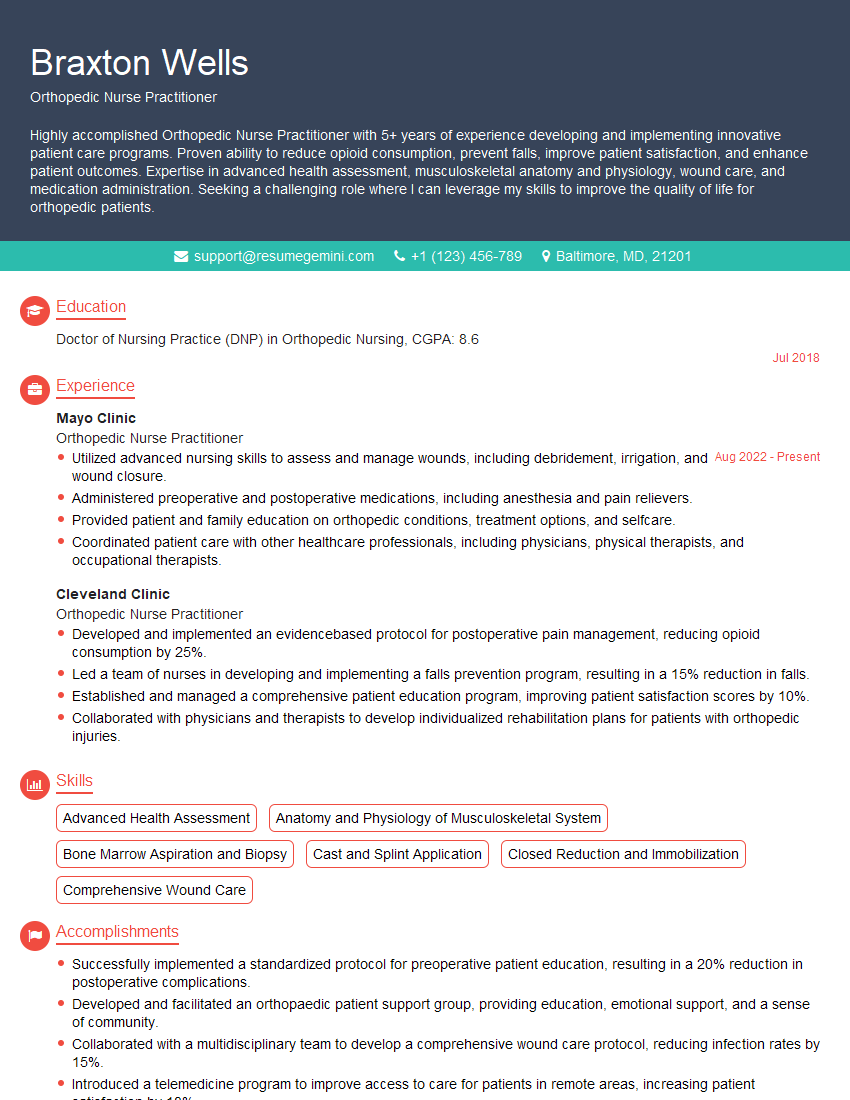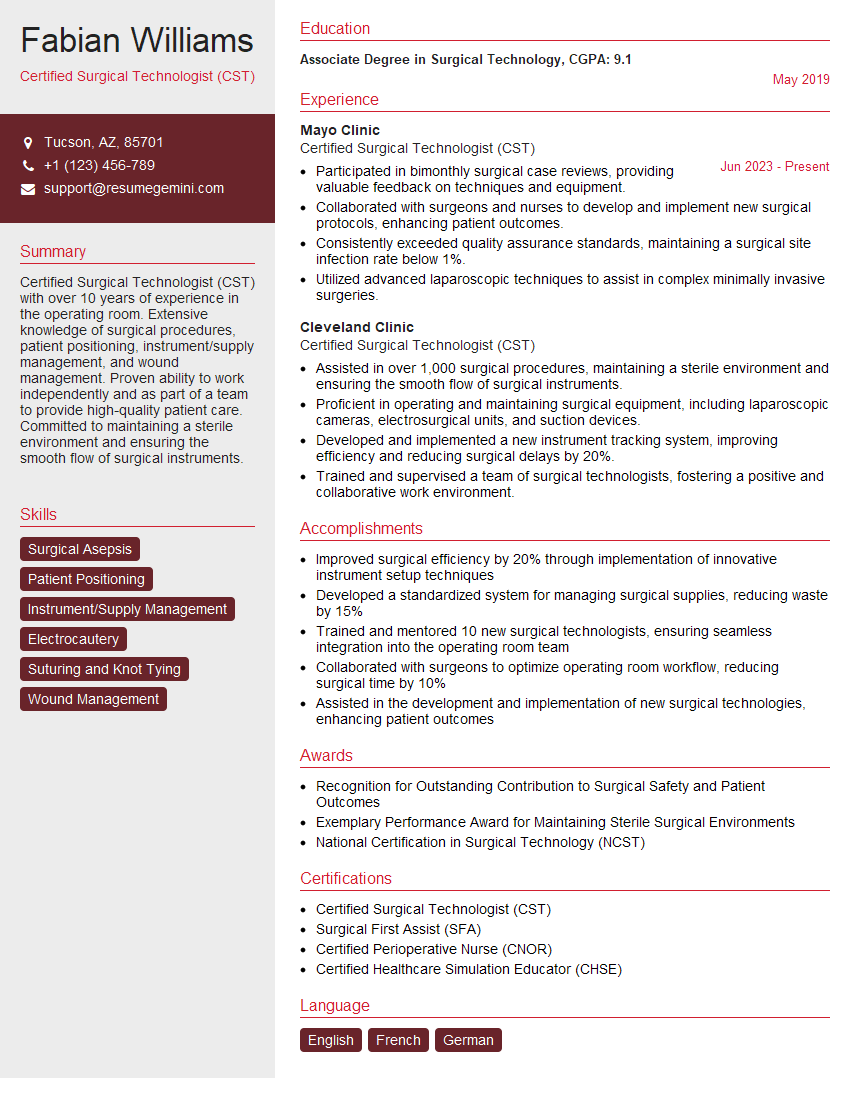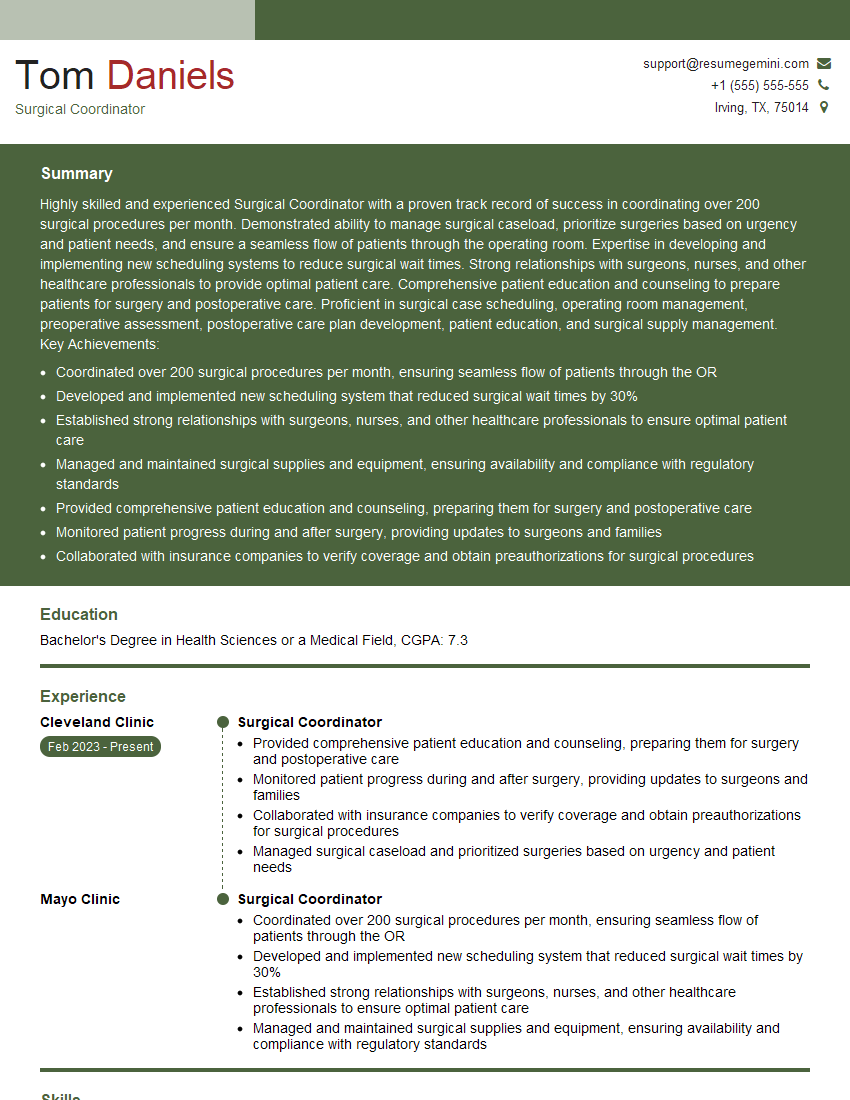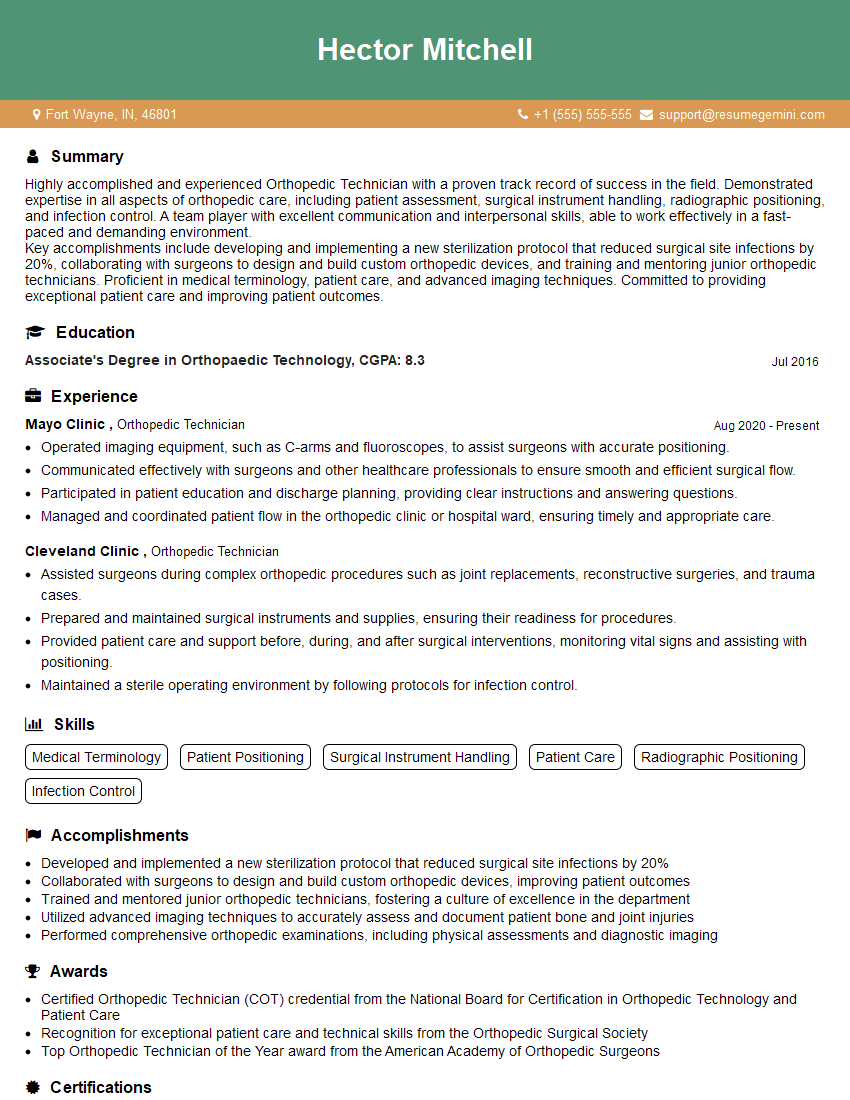Feeling uncertain about what to expect in your upcoming interview? We’ve got you covered! This blog highlights the most important Joint Replacements interview questions and provides actionable advice to help you stand out as the ideal candidate. Let’s pave the way for your success.
Questions Asked in Joint Replacements Interview
Q 1. Describe the surgical technique for a total hip arthroplasty.
Total hip arthroplasty (THA), or hip replacement, is a major surgical procedure involving the removal of damaged cartilage and bone from the hip joint and their replacement with prosthetic components. The procedure typically involves a posterior, anterior, or lateral approach.
Posterior Approach: This is the most common approach. The surgeon makes an incision at the back of the hip, moving muscles to expose the joint. The femoral head (ball) is removed, and the acetabulum (socket) is prepared. Prosthetic components, including a new femoral stem and head, and a new acetabular cup, are inserted. Muscles are then repositioned and the incision closed.
Anterior Approach: This approach involves an incision on the front of the hip, minimizing disruption to hip muscles. This can lead to potentially faster recovery and less post-operative pain, but it requires more specialized surgical skill. The procedure is similar to the posterior approach in replacing the damaged components.
Lateral Approach: This less common approach involves an incision on the side of the hip. It provides good visualization and access but may result in some muscle damage.
Throughout the procedure, meticulous attention is paid to ensuring proper component positioning and stability to achieve optimal joint function and longevity of the implant. Post-operative rehabilitation plays a crucial role in successful recovery.
Q 2. Explain the different types of prosthetic implants used in total knee replacements.
Total knee arthroplasty (TKA) or knee replacement utilizes various prosthetic implant designs, categorized primarily by the type of articulation (how the components move against each other) and the materials used.
- Cruciate-retaining (CR): These implants preserve the patient’s natural cruciate ligaments (ACL and PCL), which provide stability to the knee. This design often leads to a more natural feel but requires meticulous ligament balancing during surgery.
- Posterior-stabilized (PS): In PS implants, the posterior cruciate ligament is sacrificed. A cam mechanism on the femoral component interacts with a post on the tibial component to provide stability. This design is often preferred in cases where ligament preservation is challenging.
- Anterior-stabilized (AS): Less common now, AS designs rely on the anterior cruciate ligament, and the femoral component has a specific shape and interaction with the tibial component for stability. This design is less common now due to concerns about increased wear.
- Rotating Platform (RP): RP implants allow for some degree of rotation between the femoral and tibial components, designed to improve the natural motion of the knee and potentially reduce wear.
The implants themselves are typically made from a combination of materials: a metal alloy (like cobalt-chromium) for the femoral and tibial components, and a high-density polyethylene (plastic) for the tibial insert (the part that articulates with the femoral component). Some designs incorporate ceramic components for potentially reduced wear.
Q 3. What are the common complications associated with joint replacement surgery?
Joint replacement surgery, while highly successful, carries a risk of complications. These can be broadly categorized into:
- Infection: A serious complication requiring aggressive antibiotic treatment and potentially revision surgery. Prophylactic antibiotics are routinely used to minimize this risk.
- Dislocation: Particularly in THA, dislocation of the prosthetic components can occur, often requiring surgical reduction (putting the joint back into place).
- Fracture: Bone fractures can occur around the implant site during surgery or post-operatively.
- Nerve or vessel injury: Damage to nerves or blood vessels can lead to pain, numbness, or circulatory problems.
- Thromboembolism (blood clots): Deep vein thrombosis (DVT) and pulmonary embolism (PE) are serious risks, managed with blood thinners and compression stockings.
- Implant loosening or wear: Over time, the implant may loosen or show wear, potentially requiring revision surgery.
- Pain: While pain is expected post-operatively, persistent or severe pain may indicate a complication.
The risk of these complications varies depending on factors such as patient health, surgical technique, and implant design. Careful pre-operative planning and meticulous surgical technique can significantly reduce the incidence of complications.
Q 4. How do you manage postoperative pain in joint replacement patients?
Postoperative pain management in joint replacement patients is crucial for successful recovery. A multimodal approach is usually employed, combining different pain-relieving strategies. This often includes:
- Analgesics: Opioids (e.g., morphine, oxycodone) are often used initially for severe pain, gradually transitioned to non-opioid analgesics (e.g., acetaminophen, NSAIDs) as pain subsides.
- Regional anesthesia: Techniques like femoral nerve blocks or adductor canal blocks can provide prolonged pain relief by numbing specific nerves around the joint.
- Epidural analgesia: A catheter placed in the epidural space delivers local anesthetic and opioids, providing effective and prolonged pain control.
- Physical therapy and mobilization: Early mobilization and physical therapy help restore mobility, reduce pain, and prevent complications.
- Patient-controlled analgesia (PCA): This system allows patients to administer their own pain medication intravenously or via a pump, providing better pain control and reducing the risk of overmedication.
The specific pain management strategy is tailored to the individual patient, taking into account their medical history, pain tolerance, and response to treatment. Regular assessment and adjustment of the pain management plan are essential to ensure effective pain control and patient comfort.
Q 5. Discuss the importance of pre-operative planning for joint replacement surgery.
Pre-operative planning is essential for successful joint replacement surgery. It involves a thorough assessment of the patient’s physical and psychological condition, as well as careful planning of the surgical procedure itself.
- Patient assessment: This includes a detailed medical history, physical examination, blood tests, imaging studies (X-rays, CT scans), and assessment of the patient’s overall health and functional status.
- Implant selection: The appropriate size and type of implant are chosen based on the patient’s anatomy and the extent of joint damage.
- Surgical planning: This might involve using computer-assisted surgical techniques or 3D-printed models to optimize implant placement and surgical approach.
- Anesthesia planning: The type of anesthesia to be used (general, regional, or spinal) is determined in collaboration with anesthesiologists.
- Postoperative planning: A plan for pain management, rehabilitation, and discharge is developed to ensure a smooth recovery.
Adequate pre-operative planning minimizes risks, optimizes outcomes, and ensures that patients are well-prepared for surgery and the recovery process. It ensures a personalized and patient-centric approach to surgical intervention, drastically improving the possibility of a positive outcome.
Q 6. What are the indications and contraindications for joint replacement surgery?
Joint replacement surgery is indicated for patients with severe joint pain and dysfunction that hasn’t responded to conservative treatments such as medication, physical therapy, or assistive devices.
Indications:
- Severe pain limiting daily activities.
- Significant loss of joint function.
- Degenerative joint disease (osteoarthritis).
- Rheumatoid arthritis.
- Avascular necrosis (bone death).
- Post-traumatic arthritis.
Contraindications:
- Active infection near the joint.
- Severe medical conditions that increase surgical risks (e.g., uncontrolled diabetes, heart failure).
- Inadequate bone stock to support the implant.
- Patient’s unwillingness or inability to participate in rehabilitation.
- Unrealistic expectations of the surgery’s outcome.
A thorough evaluation by the orthopedic surgeon is crucial to determine whether joint replacement is the appropriate treatment option. The decision is made collaboratively between the surgeon and patient, weighing the potential benefits against the risks.
Q 7. Explain the different types of anesthesia used in joint replacement procedures.
Several anesthesia options are available for joint replacement procedures, each with its own advantages and disadvantages. The choice depends on the patient’s overall health, the type of surgery, and the preferences of the anesthesiologist and the surgeon.
- General anesthesia: The patient is completely unconscious during the procedure. It provides excellent muscle relaxation and pain control but carries risks associated with general anesthesia, such as respiratory depression and nausea.
- Spinal anesthesia: A local anesthetic is injected into the spinal fluid, numbing the lower half of the body. The patient remains awake but is numb from the waist down. It offers good pain control and avoids some of the risks of general anesthesia but may not be suitable for all patients.
- Epidural anesthesia: Similar to spinal anesthesia, a catheter is placed in the epidural space to deliver local anesthetic and/or opioids, providing prolonged pain relief. It allows for more precise control of pain and can be used for post-operative pain management.
- Regional anesthesia (nerve blocks): Local anesthetic is injected near specific nerves to numb the area around the joint. This can provide excellent pain control and reduce opioid requirements post-operatively. It may be combined with other anesthesia types.
The choice of anesthesia is a collaborative decision between the patient, the surgeon, and the anesthesiologist. A comprehensive discussion of the risks and benefits of each option is crucial before proceeding with surgery.
Q 8. Describe the rehabilitation protocol for a patient undergoing total hip replacement.
Rehabilitation after a total hip replacement (THR) is crucial for regaining mobility and function. It’s a phased approach, starting in the hospital and continuing at home or in a rehabilitation facility. The initial phase focuses on pain management, reducing swelling, and preventing complications like blood clots. Patients begin with gentle range-of-motion exercises, progressing to weight-bearing activities as tolerated.
- Inpatient Phase (Hospital): This typically involves several days of physical therapy, focusing on exercises to improve hip flexion, extension, abduction, and adduction. Patients are gradually encouraged to walk with assistive devices like walkers or crutches. Pain management strategies, such as medication and ice packs, are essential.
- Outpatient Phase (Home or Rehab): Once discharged, patients continue with a tailored rehabilitation program, often attending outpatient physical therapy sessions several times a week. This phase emphasizes strengthening exercises, improving balance, and regaining functional mobility for daily tasks like dressing, bathing, and climbing stairs. The duration of this phase varies based on individual progress and pre-operative functional level.
- Home Exercise Program: A vital part of recovery is the home exercise program prescribed by the therapist. This program ensures patients continue their exercises regularly, enhancing long-term outcomes. Regular follow-up appointments with the surgeon and therapist are scheduled to monitor progress and address any issues.
Think of it like learning to walk again, but with a new hip. It requires patience, consistency, and diligent adherence to the prescribed exercises. For example, a patient might initially struggle to lift their leg, but through regular exercises, they will gradually regain their range of motion and strength.
Q 9. How do you assess the success of a joint replacement surgery?
Assessing the success of a joint replacement surgery is multifaceted and goes beyond just the absence of immediate post-operative complications. We look at a combination of factors:
- Pain Relief: A significant reduction in pain, allowing the patient to resume normal activities, is a key indicator of success.
- Improved Range of Motion: The ability to move the joint freely without significant limitations is crucial.
- Functional Improvement: This measures the patient’s ability to perform daily tasks and activities of daily living (ADLs) like walking, climbing stairs, and dressing independently. Functional outcome scores like the Harris Hip Score are often used.
- Radiographic Assessment (X-rays): Regular X-rays help assess implant positioning, bone integration (osseointegration), and the absence of loosening or fractures around the implant.
- Patient Satisfaction: Ultimately, the patient’s perception of their improved quality of life is a vital indicator of the surgery’s success. This is often assessed through questionnaires.
For instance, a patient reporting significantly less pain and the ability to walk without a cane several months post-surgery, coupled with stable radiographic findings, would indicate a successful THR.
Q 10. What are the latest advancements in joint replacement technology?
Joint replacement technology has undergone remarkable advancements. Some key areas include:
- Improved Implant Designs: Newer implants are designed with better biomechanics, providing improved stability and longevity. For example, implants with more porous surfaces promote better bone integration. Some designs incorporate advanced materials, such as highly cross-linked polyethylene for increased wear resistance.
- Minimally Invasive Surgery Techniques: Smaller incisions lead to less pain, shorter hospital stays, and faster recovery times. These techniques require specialized instruments and a surgeon’s expertise.
- Computer-Assisted Surgery (CAS): CAS utilizes imaging technology to precisely plan and execute the surgery, resulting in improved implant placement accuracy and potentially better outcomes.
- Patient-Specific Implants: These implants are custom-designed based on the patient’s individual anatomy using advanced imaging techniques, leading to better fit and potentially improved longevity.
- Robotics in Joint Replacement: Robotic-assisted surgery offers improved precision, reduced invasiveness, and potentially better results compared to traditional methods.
These advancements aim to improve implant longevity, reduce complications, and improve the patient experience throughout the entire surgical journey.
Q 11. Describe the role of imaging (X-ray, CT scan, MRI) in joint replacement surgery.
Imaging plays a vital role throughout the joint replacement process.
- Pre-operative Imaging (X-ray, CT scan, MRI): These are essential for assessing the extent of joint damage, planning the surgical approach, and identifying any pre-existing conditions that might influence the procedure. For example, an MRI helps visualize soft tissues like ligaments and tendons and assess cartilage damage. CT scans provide detailed bony anatomy.
- Intra-operative Imaging (Fluoroscopy): Fluoroscopy, a type of real-time X-ray, is used during surgery to guide implant placement and confirm proper alignment.
- Post-operative Imaging (X-ray): Post-operative X-rays are used to assess implant position and stability and to monitor for complications such as loosening or fractures.
Imagine building a house; blueprints (pre-op imaging) guide the construction process, while ongoing checks during and after construction (intra-op and post-op imaging) ensure everything is built correctly and securely. This is analogous to the role of imaging in joint replacement surgery.
Q 12. How do you manage infections related to joint replacement surgery?
Infections are a serious complication of joint replacement surgery. Management involves a multi-pronged approach:
- Early Detection: Careful monitoring for signs and symptoms of infection, such as fever, swelling, pain, and drainage, is paramount. Laboratory tests, including blood cultures and joint fluid aspiration, are essential.
- Aggressive Antibiotic Therapy: Intravenous antibiotics, often a combination of multiple agents, are administered to eradicate the infection. The choice of antibiotics depends on the type of bacteria identified.
- Surgical Debridement: In cases of established infection, surgical intervention is often necessary. This involves removing the infected tissues, including bone cement, and sometimes the implant itself.
- Implant Removal and Revision Surgery: In severe cases, the infected implant may need to be removed and replaced after a period of antibiotic therapy and the infection is resolved. This revision surgery often involves extensive tissue debridement and often requires a longer period of intravenous antibiotics.
Early diagnosis and prompt treatment are crucial for preventing the spread of infection and improving patient outcomes. Delaying treatment can lead to more serious complications, necessitating more extensive surgery and a prolonged recovery period.
Q 13. Explain the concept of periprosthetic fractures.
A periprosthetic fracture is a fracture that occurs around a joint replacement implant. These fractures can happen near the bone-implant interface, within the bone itself, or in the bone further away from the implant. They can occur soon after surgery or years later. Several factors can contribute to periprosthetic fractures, including:
- Trauma: A fall or other impact can cause a fracture around the implant.
- Implant Loosening: A weakened bone around a loose implant is more prone to fracture.
- Osteoporosis: This condition weakens the bones, increasing the risk of periprosthetic fractures.
- Infection: Infection can weaken the bone, making it more susceptible to fracture.
Treatment varies depending on the location, severity, and stability of the fracture. Options may range from non-surgical management, using casts or braces, to surgical fixation, such as plates and screws, or even revision surgery.
Think of it like a crack appearing near a newly installed window frame – the frame (implant) itself might be intact, but the surrounding structure (bone) is compromised.
Q 14. What are the different types of bone cements used in joint replacement surgery?
Bone cement is used in many total joint replacements to secure the implant to the bone. The most commonly used type is polymethyl methacrylate (PMMA), which is a self-curing acrylic resin. Different formulations exist:
- Conventional PMMA: This is the most common type, providing immediate fixation of the implant.
- Low-Viscosity PMMA: This type has a lower viscosity (thinner consistency), allowing it to penetrate smaller bone spaces and improve bone cement interface.
- Antibiotic-Loaded PMMA: This incorporates antibiotics into the bone cement, reducing the risk of infection.
- Bioactive Bone Cements: These cements contain bioactive materials that promote bone growth and integration around the implant.
The choice of bone cement depends on factors such as the patient’s bone quality, the type of implant used, and the surgeon’s preference. Cementless implants are also an option, where the implant is designed to integrate directly with the bone tissue over time.
Q 15. Describe the process of selecting the appropriate implant size for a patient.
Selecting the right implant size for a joint replacement is crucial for a successful outcome. It’s not simply about matching the patient’s bone size; it’s about achieving optimal joint mechanics and stability. The process begins with a thorough preoperative assessment, including detailed imaging (X-rays, CT scans) to precisely measure the bone dimensions. We then use this data to select an implant from a range of sizes available from the manufacturer. This isn’t a one-size-fits-all approach; we consider factors like bone quality, ligament balance, and the patient’s activity level. For example, a more active patient might benefit from a slightly larger implant to handle increased stress. During surgery, we use specialized instruments and templates to ensure accurate placement and sizing, often making small adjustments intraoperatively to fine-tune the fit. It’s a meticulous process that demands both precision and experience to ensure the implant fits seamlessly and functionally.
Think of it like finding the perfect pair of shoes – you need the right size and shape not just for comfort but also for proper support and function. An implant that’s too small might loosen over time, while one that’s too large can cause irritation and bone damage. Preoperative planning and intraoperative adjustments are essential to ensuring the optimal fit.
Career Expert Tips:
- Ace those interviews! Prepare effectively by reviewing the Top 50 Most Common Interview Questions on ResumeGemini.
- Navigate your job search with confidence! Explore a wide range of Career Tips on ResumeGemini. Learn about common challenges and recommendations to overcome them.
- Craft the perfect resume! Master the Art of Resume Writing with ResumeGemini’s guide. Showcase your unique qualifications and achievements effectively.
- Don’t miss out on holiday savings! Build your dream resume with ResumeGemini’s ATS optimized templates.
Q 16. How do you counsel patients about the expectations and limitations of joint replacement surgery?
Counseling patients about joint replacement involves managing expectations and addressing limitations honestly and transparently. We discuss the potential benefits, such as pain relief, improved mobility, and improved quality of life, alongside the realistic limitations. This includes explaining that the new joint won’t be exactly like the original, and there might be some limitations in terms of range of motion or specific activities. For example, we explain that while the surgery aims to alleviate pain and improve function, it may not fully restore pre-arthritic levels of activity. We also discuss potential complications, including infection, dislocation, and implant loosening, emphasizing the importance of following post-operative instructions. Furthermore, we provide them with resources and support groups to connect with others who have undergone similar procedures. Open communication, realistic expectations, and comprehensive support are crucial for a positive patient experience.
Imagine it as preparing for a marathon. Surgery is like training – it requires dedication and effort. Success depends not just on the surgery itself, but also on the patient’s commitment to physical therapy and lifestyle changes post-surgery.
Q 17. What are the common causes of loosening and instability in joint replacements?
Loosening and instability in joint replacements are significant concerns. Loosening, a gradual process, can stem from various factors: infection (a major culprit), excessive wear and tear (particularly in highly active individuals), micromotion (tiny movements between the implant and bone), and poor bone quality (like osteoporosis). Instability, on the other hand, often arises from improper implant positioning during surgery, ligament imbalance, or trauma after the surgery. In some cases, a combination of factors contributes to both issues. For instance, infection can exacerbate loosening and potentially lead to instability. The wear particles generated by implant friction can trigger a local inflammatory response, leading to bone resorption and loosening. Careful surgical technique, proper implant selection, and patient adherence to post-operative instructions all contribute to mitigating these risks. Regular follow-up appointments, including imaging studies, are critical for early detection and management.
Q 18. Discuss the role of patient education in the success of joint replacement surgery.
Patient education is paramount to the success of joint replacement surgery. Informed patients are better equipped to manage expectations, adhere to postoperative instructions, and actively participate in their rehabilitation. We provide detailed information about the procedure, potential risks and benefits, and the rehabilitation process. This includes clear instructions on activity modification, pain management, and medication. We emphasize the importance of physical therapy to regain strength, mobility, and function. Moreover, we empower patients by teaching them how to recognize potential complications, such as infection or dislocation, and how to seek timely medical attention. A well-educated patient is more likely to achieve a favorable outcome and have a quicker recovery. The involvement of family members in the education process can also significantly enhance compliance and support.
Consider it like providing a user manual for a new piece of sophisticated equipment: without it, the patient may struggle to use and maintain it properly. A thorough education process equips the patient to effectively manage their recovery and long-term health.
Q 19. How do you manage a patient with a dislocation of a total hip replacement?
Managing a dislocated total hip replacement is a medical emergency requiring immediate attention. The first step involves reducing the dislocation – gently maneuvering the hip back into its socket under imaging guidance (usually X-ray). This usually requires sedation or anesthesia. Once reduced, we immobilize the hip to prevent redislocation, typically with a brace or sling. We then perform a thorough assessment to rule out fractures or other injuries. Depending on the cause of dislocation, we might adjust the patient’s pain medication, modify their activity restrictions, or initiate further investigations such as an MRI. In some cases, especially with recurrent dislocations, further surgical intervention may be necessary to address underlying issues like ligament instability or implant malpositioning. Patients are closely monitored for any signs of complications, and tailored physical therapy is implemented to regain function and prevent future dislocations. It’s important to emphasize the need for strict adherence to post-operative instructions to minimize the risk of recurrence.
Q 20. Explain the different surgical approaches used in total knee arthroplasty.
Total knee arthroplasty (TKA) can be performed through several surgical approaches, each with its own advantages and disadvantages. The most common approaches include the medial parapatellar, the midvastus, and the subvastus approaches. The medial parapatellar approach involves splitting the patellar tendon to access the knee joint. This provides excellent exposure but carries a slightly higher risk of patellar complications. The midvastus approach involves splitting the vastus medialis muscle, offering good exposure while minimizing patellar disruption. The subvastus approach preserves the vastus medialis muscle entirely, offering potentially less postoperative muscle weakness but may provide slightly less exposure. The choice of approach depends on factors such as the patient’s anatomy, the severity of the arthritis, and the surgeon’s experience. Minimally invasive techniques, involving smaller incisions, are also becoming increasingly popular, aiming to reduce post-operative pain and improve recovery time. The selection of the best approach requires careful consideration and is often tailored to each individual patient.
Q 21. What are the considerations for patients with osteoporosis undergoing joint replacement surgery?
Patients with osteoporosis present unique challenges for joint replacement surgery. Osteoporosis weakens bones, making them more prone to fractures and hindering implant fixation. Preoperative assessment includes bone density testing (DEXA scan) to evaluate the severity of osteoporosis. We might prescribe bisphosphonates or other medications to improve bone density before surgery. During surgery, we use special techniques to maximize implant stability, such as augmenting the bone with bone cement or bone grafts to ensure a secure fit. Careful surgical planning is crucial to avoid fractures and maximize implant longevity. Postoperatively, these patients might require more intensive physical therapy to regain strength and function, and close monitoring to detect any signs of bone loss or implant loosening. The overall goal is to achieve a stable and functional joint replacement while minimizing the risks associated with osteoporosis.
Q 22. Describe the process of evaluating a patient for suitability for joint replacement surgery.
Evaluating a patient for joint replacement involves a thorough assessment to determine if surgery is the best option and, if so, what type of implant is most suitable. It’s a multi-step process focusing on both the severity of the joint disease and the patient’s overall health.
- Medical History: A complete review of the patient’s medical history, including any pre-existing conditions like diabetes, heart disease, or lung problems, is crucial. We also look at previous surgeries, medications, and allergies.
- Physical Examination: A detailed physical exam focuses on the affected joint, assessing range of motion, pain levels, stability, and any deformities. We carefully evaluate gait and assess the patient’s functional limitations in daily activities.
- Imaging Studies: X-rays, CT scans, and sometimes MRIs are essential to visualize the joint’s anatomy, evaluate the extent of cartilage damage, bone loss, and any other abnormalities. These images help us determine the severity of the condition and plan the surgery.
- Functional Assessment: We assess the patient’s ability to perform daily activities using standardized questionnaires and functional tests. This helps us understand the impact of the joint disease on their quality of life and predict post-operative recovery.
- Laboratory Tests: Blood tests are performed to check for infections, assess overall health, and identify any potential risks associated with anesthesia and surgery.
- Patient Interview: Open communication with the patient is vital. We discuss their expectations, concerns, and goals for surgery. This helps build rapport and ensures realistic expectations.
For example, a patient with severe osteoarthritis showing significant bone-on-bone contact on X-ray, limited range of motion, and substantial pain impacting daily life would be a strong candidate for joint replacement. However, a patient with mild arthritis and good functional status might benefit more from conservative management, such as physical therapy and medication.
Q 23. How do you manage patients with pre-existing medical conditions (e.g., diabetes, heart disease) undergoing joint replacement surgery?
Managing patients with pre-existing conditions undergoing joint replacement requires a multidisciplinary approach involving careful pre-operative optimization and close monitoring post-operatively. The goal is to minimize surgical risks associated with these conditions.
- Diabetes: Tight glycemic control is essential before and after surgery to reduce the risk of infection and wound complications. We collaborate with endocrinology to optimize diabetes management.
- Heart Disease: Patients with heart disease require careful cardiac assessment before surgery. We may consult with cardiology to assess cardiac risk and optimize medications. Intraoperative monitoring is often enhanced to ensure cardiac stability.
- Lung Disease: Patients with lung conditions such as COPD might require pre-operative pulmonary rehabilitation to improve lung function and reduce the risk of postoperative respiratory complications. We often involve respiratory therapy.
- Medication Management: We carefully review all medications the patient is taking and make adjustments as necessary to minimize interactions and risks during and after surgery. Some medications may need to be temporarily stopped or adjusted.
For instance, a patient with well-controlled diabetes and stable heart disease might undergo a routine joint replacement with minimal adjustments to their medical regimen. However, a patient with poorly controlled diabetes or unstable heart failure might require a more comprehensive approach, potentially including delaying surgery until their condition is optimized.
Q 24. What are the potential long-term complications of joint replacement surgery?
While joint replacement surgery is highly successful, potential long-term complications can arise. These can be broadly categorized into mechanical issues, infection, and systemic complications.
- Mechanical Complications: Loosening of the implant, wear and tear of the implant components (leading to pain and reduced function), dislocation of the joint, fracture of the bone around the implant, and implant failure are possible.
- Infection: Deep infection around the implant is a serious complication requiring further surgery and prolonged antibiotic treatment. This can lead to implant removal and potential revision surgery.
- Systemic Complications: Blood clots (deep vein thrombosis or pulmonary embolism), nerve damage, and persistent pain can occur, although they are less common with modern surgical techniques and careful postoperative care. There’s also the possibility of allergic reactions to implant materials, though less common with modern biocompatible materials.
Regular follow-up appointments and imaging studies are crucial for early detection and management of potential complications. For example, a patient experiencing increasing pain or reduced range of motion years after a hip replacement might undergo imaging to assess for implant loosening. Early intervention can prevent more serious problems.
Q 25. Explain the importance of using sterile techniques during joint replacement surgery.
Sterile techniques are paramount during joint replacement surgery to prevent infection, a devastating complication that can lead to implant failure and the need for revision surgery. The goal is to create a completely bacteria-free environment around the surgical site.
- Preoperative Preparation: This involves thorough skin preparation of the surgical area using antiseptic solutions, the use of sterile drapes to isolate the surgical field, and the use of sterile gowns and gloves by all surgical personnel.
- Intraoperative Technique: Meticulous surgical technique, using sterile instruments, and maintaining a sterile environment throughout the procedure are crucial. Any non-sterile item or breach of sterility must be immediately addressed.
- Postoperative Care: Postoperative care continues to emphasize sterile techniques to prevent infection, including the proper care and dressing of the surgical wound. Regular monitoring for signs of infection is also critical.
Failure to maintain sterile techniques can lead to a devastating surgical site infection, requiring extensive antibiotic treatment, additional surgeries, and potentially implant removal. This highlights the absolute necessity of adhering to stringent sterile protocols throughout the entire surgical process.
Q 26. How do you address patient concerns and anxieties related to joint replacement surgery?
Addressing patient concerns and anxieties is crucial for a successful outcome. Open communication, empathy, and providing clear, concise information are key.
- Preoperative Education: Detailed explanations about the surgical procedure, potential risks and benefits, and postoperative recovery expectations help alleviate anxiety. We use visual aids and patient handouts.
- Addressing Specific Concerns: We proactively address patient concerns related to pain management, rehabilitation, and potential complications. We answer their questions patiently and honestly.
- Pain Management Plan: A comprehensive pain management plan, including both pharmacological and non-pharmacological approaches, is crucial for easing anxieties about postoperative pain.
- Rehabilitation Planning: A clear plan for rehabilitation, outlining the steps and timelines, helps patients feel more in control and less anxious about recovery.
- Support System: Encouraging patients to involve their support system (family, friends) in the decision-making process helps alleviate anxieties and provides emotional support.
For example, I often spend time discussing the realistic expectations of recovery, explaining that there will be discomfort and a gradual return to normal activities. I also reassure patients that we will closely monitor their progress and address any concerns promptly.
Q 27. Discuss the role of minimally invasive techniques in joint replacement surgery.
Minimally invasive techniques in joint replacement surgery aim to reduce the size of the incision, minimize tissue trauma, and improve recovery. These techniques offer several potential advantages over traditional open surgery.
- Smaller Incisions: Smaller incisions lead to less pain, reduced blood loss, faster healing, and improved cosmesis (better scarring).
- Less Tissue Trauma: Minimally invasive approaches cause less damage to surrounding muscles, tendons, and ligaments, potentially leading to quicker rehabilitation and improved functional outcomes.
- Faster Return to Activities: Patients may be able to return to their daily activities sooner after minimally invasive surgery.
However, minimally invasive techniques require specialized training and equipment. They might not be suitable for all patients, particularly those with severe joint deformities or complex medical conditions. The choice between minimally invasive and traditional open techniques depends on the individual patient’s anatomy, the severity of their condition, and the surgeon’s expertise.
Q 28. Describe your experience with revision joint replacement surgery.
Revision joint replacement surgery is a complex procedure involving the removal of a failed or infected implant and the insertion of a new prosthesis. It is often more challenging than primary joint replacement due to the presence of scar tissue, bone loss, and potential infection.
- Causes of Revision: Revision surgery is often necessary due to implant loosening, infection, fracture, or wear and tear. It may require bone grafting, use of specialized implants, and more extensive surgical procedures.
- Challenges of Revision: Revision surgery is more demanding technically due to the altered anatomy and the need for meticulous debridement of infected tissue if present. It requires specialized surgical techniques and experience.
- Postoperative Care: Postoperative care after revision surgery is often more intensive, with a longer rehabilitation period needed for a full recovery.
I have extensive experience performing revision joint replacement surgeries, utilizing advanced techniques and implants to achieve the best possible outcomes. The decision to pursue revision surgery is made on a case-by-case basis, carefully weighing the risks and benefits with the patient.
Key Topics to Learn for Joint Replacements Interview
- Surgical Techniques: Understand various approaches (anterior, posterior, minimally invasive), their advantages, disadvantages, and patient selection criteria. Consider the nuances of different joint replacements (hip, knee, shoulder).
- Implant Selection and Design: Familiarize yourself with different implant materials, designs, and their biomechanical properties. Be prepared to discuss factors influencing implant choice and potential complications related to implant failure.
- Pre-operative Planning and Assessment: Understand the importance of thorough patient evaluation, including medical history, imaging interpretation, and functional assessments. Know how to identify potential risks and contraindications.
- Post-operative Management and Rehabilitation: Discuss pain management strategies, physical therapy protocols, and common post-operative complications. Be prepared to explain the role of different healthcare professionals in the rehabilitation process.
- Complications and Management: Be familiar with common complications such as infection, dislocation, instability, and nerve injury. Understand their diagnosis, management, and prevention strategies.
- Advanced Technologies and Techniques: Explore the use of robotics, navigation systems, and 3D printing in joint replacement surgery. Understand their benefits and limitations.
- Patient Communication and Counseling: Discuss the importance of effective communication with patients and their families regarding the surgical procedure, recovery process, and potential risks and benefits.
Next Steps
Mastering the intricacies of Joint Replacements significantly enhances your career prospects in orthopedics and related fields. It demonstrates a high level of expertise and commitment to patient care. To maximize your job search success, it’s crucial to present your skills and experience effectively. Building an ATS-friendly resume is key to getting your application noticed. ResumeGemini is a trusted resource that can help you craft a compelling and optimized resume. Take advantage of their tools and resources, including examples of resumes tailored to Joint Replacements, to build a document that truly showcases your capabilities and lands you that dream interview.
Explore more articles
Users Rating of Our Blogs
Share Your Experience
We value your feedback! Please rate our content and share your thoughts (optional).
What Readers Say About Our Blog
This was kind of a unique content I found around the specialized skills. Very helpful questions and good detailed answers.
Very Helpful blog, thank you Interviewgemini team.

